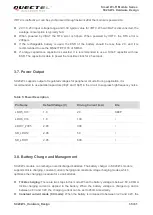
Smart Wi-Fi Module Series
SC20-WL Hardware Design
SC20-WL_Hardware_Design
35 / 81
If RTC is ineffective, it can be synchronized through network after the module is powered on.
2.0V~3.25V input voltage range and 3.0V typical value for VRTC. When VBAT is disconnected, the
average consumption is typically 5uA.
When powered by VBAT, the RTC error is 50ppm. When powered by VRTC, the RTC error is
200ppm.
If the rechargeable battery is used, the ESR of the battery should be less than 2K, and it is
recommended to use the MS621FE FL11E of SEIKO.
If a large capacitance capacitor is selected, it is recommended to use a 100uF capacitor with low
ESR. The capacitor is able to power the real-time clock for 45 seconds.
3.7. Power Output
SC20-WL supports output of regulated voltages for peripheral circuits. During application, it is
recommended to use parallel capacitors (33pF and 10pF) in the circuit to suppress high frequency noise.
Table 5: Power Description
3.8. Battery Charge and Management
SC20-WL module can recharge over-discharged batteries. The battery charger in SC20-WL module
supports trickle charging, constant current charging and constant voltage charging modes, which
optimizes the charging procedure for Li-ion batteries.
Trickle charging:
There are two steps in this mode. When the battery voltage is below 2.8V, a 90mA
trickle charging current is applied to the battery. When the battery voltage is charged up and is
between 2.8V and 3.2V, the charging current can be set to 450mA maximally.
Constant current mode (CC mode):
When the battery is increased to between 3.2V and 4.2V, the
Pin Name
Default Voltage (V)
Driving Current (mA)
Idle
LDO5_1V8
1.8
20
KEEP
LDO6_1V8
1.8
100
/
LDO17_2V85
2.85
300
/
SD_LDO12
2.95
50
/
SD_LDO11
2.95
600
/
















































